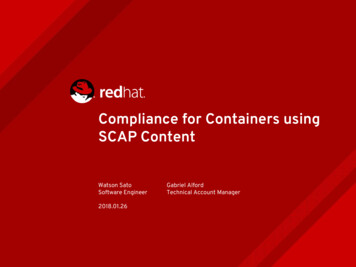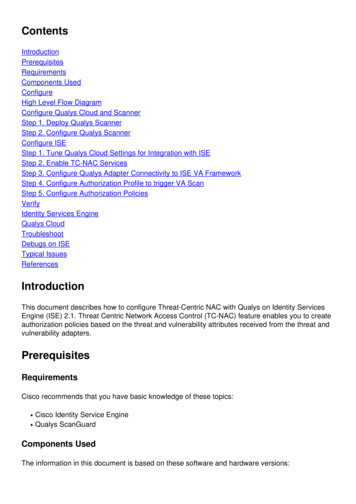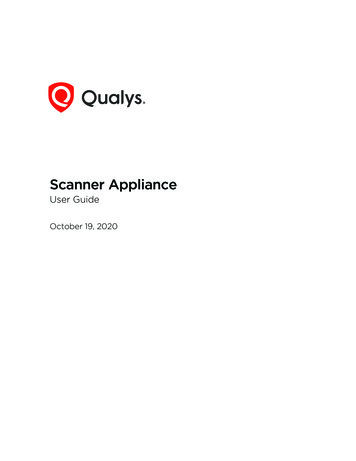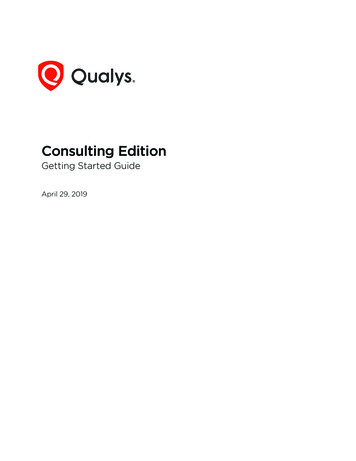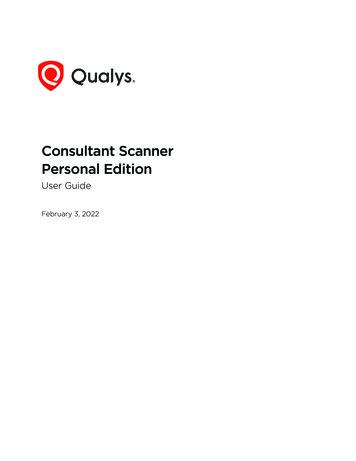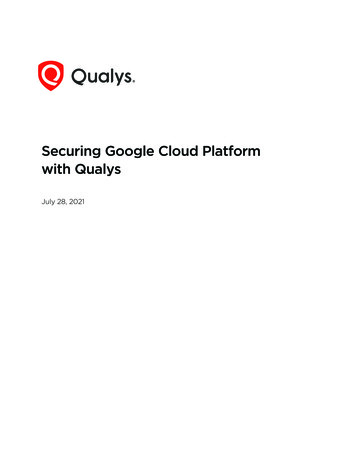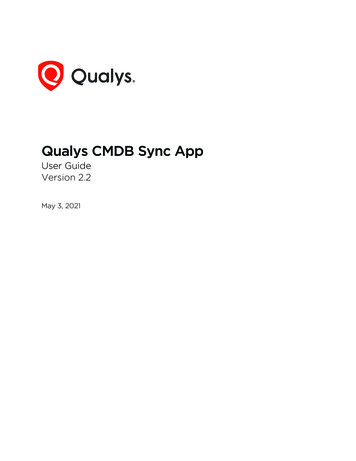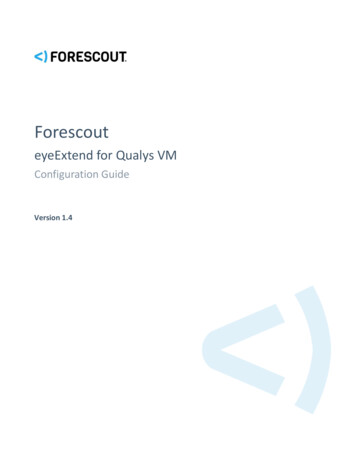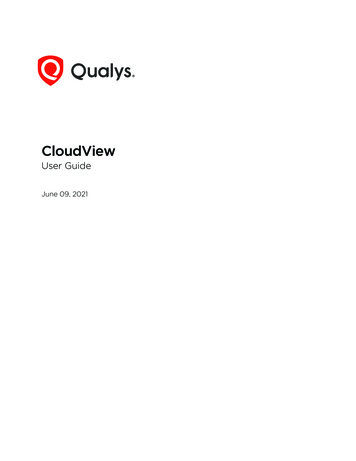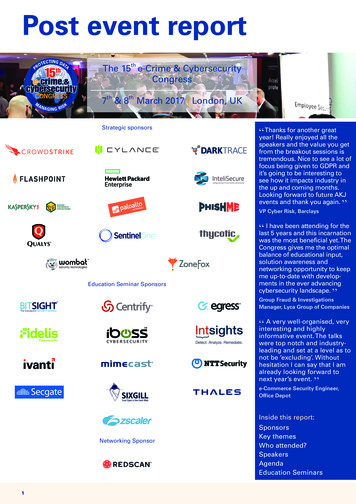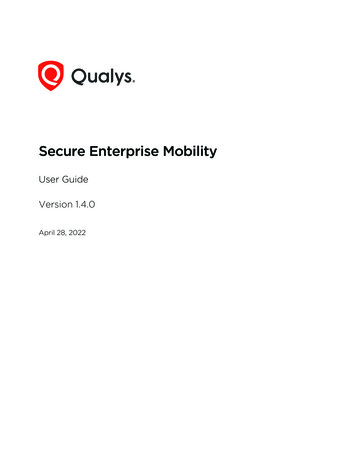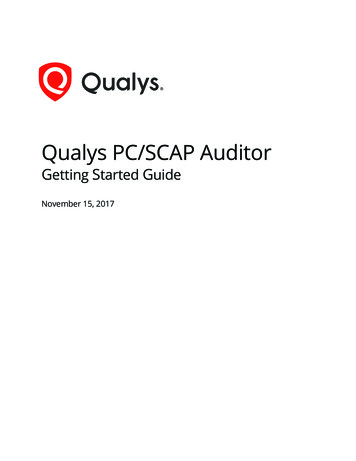
Transcription
Qualys PC/SCAP AuditorGetting Started GuideNovember 15, 2017
COPYRIGHT 2011-2017 BY QUALYS, INC. ALL RIGHTS RESERVED.QUALYS AND THE QUALYS LOGO ARE REGISTERED TRADEMARKS OF QUALYS, INC. ALL OTHER TRADEMARKS ARE THE PROPERTY OF THEIRRESPECTIVE OWNERS.QUALYS, INC.919 E HILLSDALE BLVDFOSTER CITY, CA 944041 (650) 801 6100
Table of ContentsWelcome .4Set Up Policies. 6What do I need to get started? . 6How to import a policy from the library . 6How to create a policy with SCAP 1.2 content . 7How to create a policy with SCAP 1.1/1.0 content . 8How to create a policy with OVAL content . 9Start Scanning . 10What do I need to get started? . 10How to start a scan . 10Tell me about scan results . 12How to verify that authentication worked . 13How to schedule your scans . 13Reporting . 14SCAP Scorecard Report . 14SCAP Policy XML Report . 15SCAP Policy CSV Report . 15Rule Pass/Fail Report . 16Individual Host Report . 18SCAP ARF Report . 20Contact Support. 20Verity Confidential
WelcomeWelcome to Qualys SCAP Auditor, the cloud-based computing solution for Security ContentAutomation Protocol (SCAP) compliance. SCAP requires federal agencies to standardize theconfiguration of computer systems to strengthen IT security. This user guide will walk youthrough completing your first SCAP scans and creating reports showing your SCAP compliance.Qualys SCAP Auditor 1.2Qualys SCAP Auditor 1.2 is a subscription based, Software as a Service solution delivered viaQualys Policy Compliance 8.x and the Qualys Cloud Platform. The SCAP features are versionedindependently from other services available via the Qualys portal. Changes to the Qualys SCAPAuditor version number will indicate changes related to SCAP scanning. Qualys SCAP Auditor1.2 supports USGCB scanning for internal systems on a global scale.For more information about Qualys SCAP Auditor 1.2, please visit the following cap/Tell me about availabilityThe SCAP application must be enabled for your account. Not sure if it’s enabled? Go to Help Account Info and see if there’s a SCAP Summary section. If yes, then SCAP is turned on.You’ll also need compliance management permissions. All Managers and Auditors have thispermission. For sub-users, a Manager can grant you the “Manage PC module” permission byediting your user account.SCAP complianceCompliant with SCAP version 1.2: XCCDF 1.2, OVAL 5.10, CCE 5, CPE 2.3, CVE, and CVSS 2,OCIL 2.0, CCSS 1.0, Asset Identification 1.1, ARF 1.1, TMSAD 1.0Compliant with SCAP version 1.0/1.1: XCCDF 1.1.4, OVAL 5.3, CCE 5,CPE 2.2, CVE, and CVSS 2SCAP 1.2 conformanceOur SCAP application conforms with requirements in the SCAP 1.2 specification for the use casecompliance checking (with the @use-case attribute in the ds:data-stream element set toCONFIGURATION). We are a consumer of SCAP content, meaning we accept existing SCAPsource data stream content, process it, and produce valid SCAP result data streams.SCAP 1.2 certificationAuthenticated Configuration Scanner with the CVE option for assessment of Windows 7 (32 and64 bit) and Red Hat Enterprise Linux (RHEL) 5 Desktop (32 and 64 bit) providing the ability toaudit and assess a target system to determine its compliance with USGCB requirements.
Qualys SCAP Auditor Getting Started GuideWelcomeBackward compatibilitySCAP Auditor 1.2 provides backward compatibility with SCAP 1.0 for assessment of WindowsXP and Windows Vista supporting USGCB and FDCC assessment. We are certified for thesecapabilities for SCAP 1.0: FDCC Scanner, Authenticated Configuration Scanner, AuthenticatedVulnerability and Patch Scanner, and Unauthenticated Vulnerability Scanner.Additional assessment capabilitiesIn addition to the SCAP certified assessment capabilities, SCAP Auditor can process SCAP tier IIIcontent intended for the following systems: Windows 7 (32 and 64 bit), Windows XP (32 bit),Windows Vista, Windows 2008, Windows 2012, RHEL 5 (32 and 64 bit) and most Linuxdistributions.Where can I learn more?Please refer to “Statement of SCAP Compliance” in the online help. Log in to the Qualys userinterface, go to Help Online Help and use the Search feature to find this help file.5
Set Up PoliciesWe provide pre-defined SCAP policies that are compliant with SCAP requirements 1.0 or 1.2. Youcan easily import one of these policies from our SCAP Policy Library. All SCAP policies in thelibrary have been validated by the NIST standards. Also you can create a custom policy byuploading your own SCAP or OVAL content.What do I need to get started?Compliance hosts in your accountMake sure the hosts you want to check for compliance are defined in your account as ComplianceHosts. Go to PC Assets Host Assets and you’ll see the compliance hosts (IP addresses) alreadyin your account. You can add compliance hosts (up to the limit for your license) by selectingNew IP Tracked Hosts.Asset groups with compliance hostsWhen you import or create a policy, you’ll need to assign asset groups to the policy. The assetgroups include the compliance hosts you want to scan against the policy. Go to Assets AssetGroups New Asset Group to add one.How to import a policy from the libraryGo to PC Policies and select New Import SCAP Policy. Then click the Import button for theSCAP policy you want.
Qualys SCAP Auditor Getting Started GuideSet Up PoliciesAn import status appears like this and we recommend you assign assets now. Be sure to assignasset groups with relevant hosts (for example, add Windows 7 hosts to a Windows 7 policy).How to create a policy with SCAP 1.2 contentGo to PC Policies and select New SCAP Policy.Select the option “SCAP version 1.2” and browse to the data stream collection file. Click Next.7
Qualys SCAP Auditor Getting Started GuideSet Up PoliciesWe’ll perform schema validation. Any errors will be reported online and must be resolved tocontinue. Upon successful validation, you’ll see SCAP benchmark details. Use the drop-downs toselect the source data stream ID, the benchmark ID and the profile title (which corresponds to theprofile ID) intended for evaluation. Important - Once you save the policy, you cannot modifythese selections. You can, however, create new policies with different selections. Click Create toadd the policy to your account.As stated earlier, you’ll need to assign assets to your policy if you want to scan against it. Werecommend you do this now. After selecting asset groups click Assign Assets.How to create a policy with SCAP 1.1/1.0 contentThe steps are similar to version 1.2 described above. In this case, you’ll select the option “SCAPversion 1.1/1.0” in the New SCAP Policy window. Then select the XCCDF content file plusadditional data files. Click Next and we’ll perform schema validation. Please resolve any contenterrors reported online. Once you pass schema validation, select a SCAP benchmark - you cancustomize the details if you want. Click Create to save your new policy. Next assign assets to yourpolicy and you’ll be ready to scan.8
Qualys SCAP Auditor Getting Started GuideSet Up PoliciesHow to create a policy with OVAL contentTo create a SCAP policy with OVAL content, you’ll select the option “Custom OVAL definitions &external variables” in the New SCAP Policy window. Then select content to be uploaded - anOVAL definition file and optionally an OVAL external variable file. Click Next.The benchmark is automatically generated for your policy. The policy will be added to youraccount with the type OVAL once you click Create.Next assign assets to your policy and you’ll be ready to scan.9
Start ScanningSCAP Scanning analyzes the SCAP compliance of hosts on your network. When you launchSCAP scans, the service safely and accurately measures compliance against a SCAP policy usingits Inference-Based Scanning Engine, an adaptive process that intelligently runs only testsapplicable to each host scanned.What do I need to get started?Scanner Appliance enabled for SCAP scanningThe SCAP option must be enabled on a scanner appliance to support SCAP scanning.Check the appliance software version - The scanner appliance must be running software version2.4 or later. You’ll find the version number in your account by going to the appliances list (Scans Appliances) and viewing the appliance info (select the appliance, then select Info from the QuickActions menu). You can also find the software version in the appliance user interface. On themain menu select VERSION INFO.Edit the appliance settings - Go to PC Scans Appliances. Edit the appliance you want to usefor SCAP scanning. Select the “Enable SCAP” option and then click Save.Authentication records for your target hostsAuthentication to hosts is required for SCAP scans using an account with Administrator rights.You’ll want to add the credentials to be used for scanning in an authentication record. Go to PC Scans Authentication. Select New Windows Record or New Unix Record. You’ll beprompted to enter your credentials and target hosts. Tip - Click the Launch Help link within therecord for help with the settings.How to start a scanGo to PC Scans SCAP Scans and select New Scan.
Qualys SCAP Auditor Getting Started GuideStart ScanningThe Launch SCAP Scan wizard appears, prompting you to enter scan settings.1. Select a SCAP policy to be evaluated by the scan. The menu lists all SCAP policies defined inyour account. Click the View link to see the current settings for a selected policy.2. Select a compliance profile to apply to this SCAP scan. Configuration settings defined in thecompliance profile will affect your results. The menu is empty until you (or another user in thesubscription) create a compliance profile.3. Select a scanner appliance that has been enabled for SCAP scanning.Click the Launch button after entering information.You can track the scan status on the SCAP Scans list. You will receive a scan summary emailnotification when the scan completes if this notification option is turned on in your account.11
Qualys SCAP Auditor Getting Started GuideStart ScanningTell me about scan resultsSample SCAP scan results are below.You’ll notice the Appendix includes: Hosts Scanned/Not Scanned, Host Technology Not inPolicy (CPE mismatch), Hostname Not Found, Windows authentication was successful/notsuccessful, and compliance profile settings.12
Qualys SCAP Auditor Getting Started GuideStart ScanningTips:Once your scan is finished and scan results are processed, you can launch SCAP reports todetermine whether hosts are compliant with a SCAP policy. Keep reading to learn how to launchSCAP compliance reports.Tell me about “No data found”. If you run a SCAP scan and it returns the status “Finished” withthe message “No data found” it’s most likely that authentication was not successful on the targethosts. Be sure to create authentication records for the systems you want to scan. Also check thatthe credentials in the records are current.How to verify that authentication workedWe recommend you run the Authentication Report to determine whether authentication wassuccessful for all of the target hosts. Authentication must be successful in order for us to evaluateeach host for SCAP compliance. To run this report go to PC Reports and select New Compliance Report Authentication Report.How to schedule your scansBy scheduling scans you’ll get SCAP scan results on a regular basis (daily, weekly or monthly)and during a time window convenient for your organization. It’s easy to schedule a scan. Just goto PC Scans Schedules and select New Schedule Scan SCAP.13
ReportingSpecialized SCAP compliance reports provide the SCAP status of hosts in your account, based onthe most recent SCAP scan results. These reports help you determine whether hosts arecompliant with the SCAP policies in your account.Go to PC Reports to create new SCAP reports from the New menu (except the SCAP ARF reportwhich is launched from the API). SCAP reports are described below.SCAP Scorecard ReportThe SCAP Scorecard Report gives you a high-level summary of the current SCAP compliancestatus of a SCAP policy in your account. To run this report go to PC Reports, select New SCAP Report Scorecard Report, select settings and click Run.Sample SCAP Scorecard Report:
Qualys SCAP Auditor Getting Started GuideReportingSCAP Policy XML ReportThe SCAP Policy XML Report determines an organization’s compliance with the SCAP mandatefor compliance hosts in a selected SCAP policy. To create this report go to PC Reports and selectNew SCAP Report Policy Report, and choose the XCCDF TestResult (XML) format. Once youclick Run we’ll create your report and you’ll see it in the reports list.Sample SCAP Policy XML Report:The areas of the XCCDF specification that have been constrained for use with the SCAP profileappear in TestResult elements and rule-result sub-elements.SCAP Policy CSV ReportYou can also run the SCAP Policy Report in CSV format. This allows you to import the data toexternal systems or to open the data in spreadsheet format. Simply choose the CSV format whenrunning your report.Sample SCAP Policy CSV Report:15
Qualys SCAP Auditor Getting Started GuideReportingRule Pass/Fail ReportThe Rule Pass/Fail Report identifies the SCAP compliance status for a particular rule. When yourun this report, you’ll specify a SCAP policy and a rule from that policy to report on. Go to PC Reports, select New SCAP Report Interactive Rule Pass/Fail and click Run.The report setup window prompts you to select report settings. Once you click Run thecompleted report appears in the same window.Tips:Use the Display option to filter the hosts displayed in the report based on posture. You have theseoptions: Passed (Fixed), Failed (includes Error and Unknown) or Ignored (includes NotApplicable, Not Checked, Not Selected and Informational).You can modify the report settings to change the report output in real-time. Go to View SetupPane from within the report. Modify the settings and click Run to update the results.Interactive reports are not saved to your reports list. You can download and print the report fromthe File menu within your report.16
Qualys SCAP Auditor Getting Started GuideReportingSample Rule Pass/Fail Report:Each host in the report is listed on a separate line with the posture for the selected rule.How is posture determined?Our service evaluates the test results for all the nodes (definitions and test sections) according tothe rule and determines whether the host satisfied the conditions of the rule.Passed - The test results for all the nodes satisfied the conditions of the rule.Failed - In a case where the evidence has a node with the result Error or Unknown, our servicewill assign the posture Failed since the host did not satisfy the conditions of the rule. If the resultis Error, you’ll see Failed (Error). If the result is Unknown, you’ll see Failed (Unknown).A rule is ignored if you see one of these postures: Not Applicable, Not Checked, Not Selected orInformational. Not Checked indicates that the rule refers to checks in checking systems other thanOVAL. This includes OCIL checks.How do I find the Patches Report?The rule titled “Security Patches Up-To-Date” provides evidence for special patches tested duringthe most recent SCAP scan of each host in the SCAP policy. These include all patches defined inthe “patches” file in the SCAP policy when present. For each host you’ll see the patch status. Thestatus Pass indicates the patch was found during the last SCAP scan on the host, and the statusFail (in Red) indicates the patch was not found during the last SCAP scan on the host.17
Qualys SCAP Auditor Getting Started GuideReportingIndividual Host ReportThe Individual Host Report identifies the SCAP compliance status for a particular host. Whenyou run this report, you’ll specify a SCAP policy and a single host to report on.Go to PC Reports, select New SCAP Report Interactive Individual Host and click Run.The report setup window prompts you to select report settings.18
Qualys SCAP Auditor Getting Started GuideReportingSample Individual Host Report:Each rule from the SCAP policy that is applicable to the host is listed with the posture andposture evidence when included.Interested in OVAL definitions?If you ran your report on a policy with custom OVAL definitions, you can go to File Downloadto download the OVAL definitions in XML format.19
Qualys SCAP Auditor Getting Started GuideContact SupportSCAP ARF ReportYou can launch a SCAP scan report in Asset Reporting Format (ARF) using our API, arequirement in the SCAP 1.2 specifications from NIST.How do I launch this report?Use the SCAP ARF Report API v2 (the resource /api/2.0/fo/compliance/scap/arf/). You’ll needto provide the scan ID for a finished SCAP scan and optionally IPs if you want to limit the reportto certain IP addresses only.Not sure how to find the scan ID? You’ll see the scan ID when viewing SCAP scan results in theuser interface. In the scan results window’s title bar you’ll see the report URL with its ID numberin the “id” parameter, like fdcc scan result.php?id 3362251API RequestHere’s a sample API request:curl -u "USERNAME:PASSWORD" -H "X-Requested-With: Curl" -X POST -d"scan id 3362251&ips pi.qualys.com is the API server URL for US Platform 1. If your account is locatedon one of our other cloud platforms then you’ll want to replace this base URL with the one that isappropriate for your location. For example, for US Platform 2, usehttps://qualysapi.qg2.apps.qualys.com. For the EU Platform, use https://qualysapi.qualys.eu. Ifyou have an @Customer platform, use a URL like https://qualysapi. customer base url .XML OutputThe XML output is compliant with the ARF 1.1 Schema. Show me the SchemaWhere can I learn more about using the API?Refer to the API V2 User Guide for a better understanding of API conventions and detailedinstructions on using API functions. Get the latest from the Community. Go to the CommunityContact SupportQualys is committed to providing you with the most thorough support. Through onlinedocumentation, telephone help, and direct email support, Qualys ensures that your questionswill be answered in the fastest time possible. We support you 7 days a week, 24 hours a day.Access online support information at www.qualys.com/support/.20
The Launch SCAP Scan wizard appears, prompting you to enter scan settings. 1. Select a SCAP policy to be evaluated by the scan. The menu lists all SCAP policies defined in your account. Click the View link to see the current settings for a selected policy. 2. Select a compliance profile to apply to this SCAP scan. Configuration settings defined .
